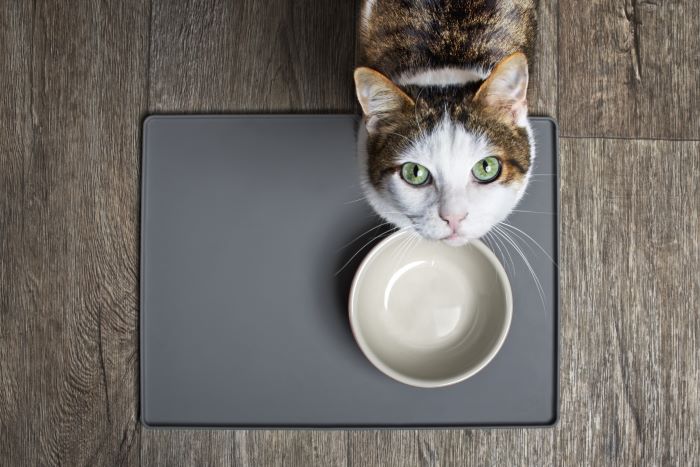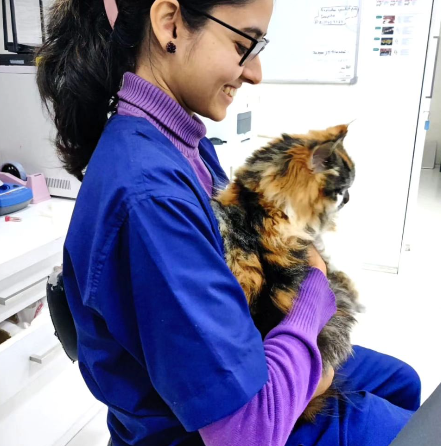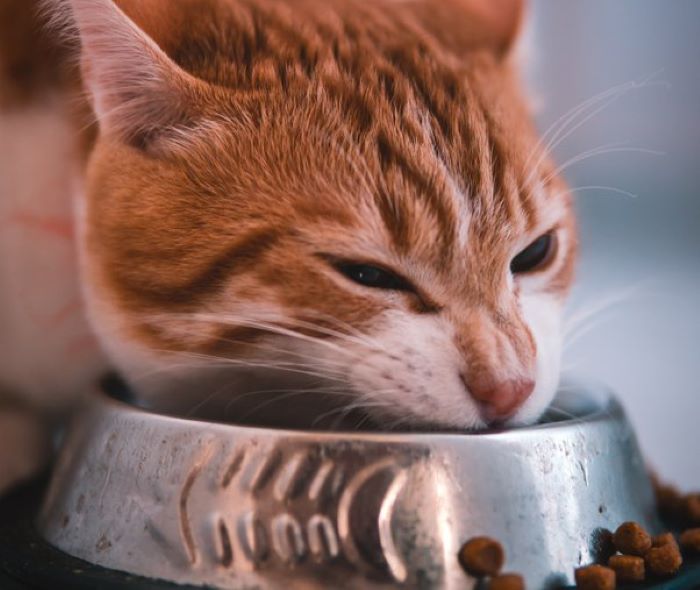Cats are an enigma among the animal kingdom. They have a lot of quirks and habits that make them intriguing to people. One thing about cats is they like to leave their food bowl when they think it is empty, but the truth is it is never really empty. Cats can sense when their owner refills or replaces their water dish and will come back for more.
One possible reason why your healthy cat may think their bowl is empty, even if there is still food inside of it, is that they may not be able to see the food. This can be due to them having a poor vision or because the food is hidden underneath the water in their bowl.
Another possibility is that your cat simply doesn’t like their food and isn’t interested in eating it no matter how much is left in their bowl. In this case, you may need to switch up your cat’s diet and find something they are more inclined to eat.
Regardless of the cause, it’s critical to comprehend your cat’s actions and why they do what they do. This way, you can better care for them and ensure they live a happy, healthy life. However, there are several points to describe why do cats think their food bowl is empty. Let’s find out.
Why Does My Cat Feel Like Their Meal Dish Is Vacant?

When cats detect human cooking or discover food, they become ravenous. You will offer them food, and they’ll continue to mew for more after a few minutes. However, a cat should be full by now. At the absolute most, you would expect the cat to consume its food in its bowl at some time.
Many cat owners have reported observing their pets engaging in unusual activities. One of the most prevalent cat behaviors is digging in their food or drinking water bowls. So, why do cats act as though their bowl is empty?
A Natural Instinct
A type of conservation technique that enables them to maintain as much food as feasible (essentially hoarding it) is a legacy from their wild forefathers. Burying food to prevent others from eating it, discourage predators, or save it for later consumption is a common feline behavior. Cats, like members of the cat family, will show this as a trait that isn’t in their nature.
Cats who live inside do not bury their food since they are not scavengers like wild cats, however, they will leave some in their dishes for later consumption. Cats require tiny, precise portion-controlled meals every few hours throughout the day, so keep an eye on how much your cat consumes and adjust the amount you give him/her as needed. You may also try filling puzzle feeders with food to encourage your cat to search for it.
Cat Whiskers
If you watch your cat carefully, you’ll notice that their whiskers (vibrissae) are constantly moving. This is because the whiskers are essential for helping the cat understand its surroundings. The whiskers send messages to the brain about air movements, textures, and shapes near the cat’s face.
It is believed that when a cat eats, it uses its whiskers to determine how much food is in its dish. If there isn’t enough food in the dish or if the food is hidden underneath the water, then the cat will think the food tray is empty. Another thing to consider is whisker stress in cats. Feline friends that have whisker stress act like their food bowl is completely empty.
Concerns About Behavior
When your cat despises the particular food, is unwell, or is in discomfort, they may eat less and even leave half-eaten meals in their dish. Keep an eye on your pet for any strange activities, as cats employ a variety of strategies to communicate with their people.
It’s as crucial what you give your cat as what you feed them. Given this in mind, putting up a feeding plan that includes frequent meals and water will keep them healthy. A cat’s day is spent largely eating and sleeping. Cats, of course, spend more than half of their time hunting for food. When cats consume meals from food bowls, they are deprived of their natural urge to search for food.
Another thing to consider, cats prefer different food each day you provide them meals. My cat didn’t like dry food consisting of chicken, so I tried a wet chicken sachet and she started to eat it happily.
Insecure About Food
Cats, especially young cats, may believe that their food supply is in danger. This is especially true if the cat dishes are placed outside, where other cats and dogs may be present, or in a house where many more than one cat is fed.
Strays and young cats, in particular, have a tendency to eat too fast, resulting in regurgitation of their meal. To prevent this, keep your cat’s food bowl in a specific place or room where it will not be disturbed.
If you have more than one cat or other pet, you’ll need to figure out how to feed them on their own. This ensures that your cat’s food will not be eaten or taken away by other animals or people.
Food And Water Tray Size Matters
Cats may be unwilling to eat from a particular shape or size of feeder dish. Although deep and narrow feeding bowls are the most frequent cat-eating vessels, they aren’t particularly suited to them. This is the fact that cat’s whiskers are sensitive. Mostly, cats refuse to eat out of deep, narrow bowls altogether.
When food is placed near the center of the dish, cats will eat it from there while leaving the corners and edges alone. The greatest choices are bowls with shallow sides that keep food or water from spilling or tiny, oval-shaped dishes with little sides that prevent spillage.
When it comes to water bowls, make sure they’re big enough for them to drink from the middle and avoid whisker fatigue, especially in old cats. Keep in mind that some elderly cats digest better if the bowl is slightly elevated while feeding your cat.
The Location of the Meal and Water Pan Also Matters
Some cats have been observed preferring their water bowl to be in a different location than their food bowl because it satisfies their animal instincts, while others want their water to be as close to their food as possible.
Cats avoid consuming food within arm’s reach of their water source because they believe prey body toxins would pollute the water. If food is in close proximity to their drinking source, such cats will remove it from their dish and eat it elsewhere.
Place your cat’s water and food bowls in the most natural spot to encourage eating, based on their preferences. Cat eats food when the place is completely neat and clean same as your own dining table.
Cats Want Good Hygiene
Cats won’t eat from filthy bowls, instead of digging through the meal rather than consuming if the bowl isn’t clean enough. Make sure your cat’s food and water bowls are kept clean, just like your own. Cats are tiny and charming, but they have delicate bodies that like to be groomed, especially by licking. Keep your cat’s food and drinking bowls away from litter boxes, waste, and filthy locations.
It is instinctive for cats not to eat rubbish and even overcooked food, so they will prefer to dig into their bowl instead. When your cat has had enough to eat, don’t tip the bowl over; instead, clear it and disinfect it, as well as the surrounding area. You then offer water to your cat. Also, provide wet food to your cat 3 times a day because it is important.
Glass, ceramic, and stainless steel are the most effective at keeping your cat’s food bowl clean. Plastic causes micro-abrasions that allow germs to spread, so avoid it. Bacterial infections are one of the primary causes of vomiting in cats, so select a material other than plastic to keep bacteria at bay.
A Change In Cat’s Diet
Is it possible to consume the same meal for a few days or maybe a week? No. It’s also impossible for your cat. If your cat won’t eat, play with its food, or appear as if its food tray is empty, they’re most likely in need of a diet change. To keep your cat eating well, offer a range of pet snacks and even gourmet cuisine.
You may also give them additional nutrients to help them eat more. Your cat may dislike particular meals for a variety of causes, including allergies or just because they’re unpleasant. Remove any tastes or components from your cat’s diet that he or she appears to be repulsed by.
Stale Food Vs Fresh Food
Cats have been discovered to detect spoilt food or drink and somewhat stale human meals with ease. They will also refuse to eat from it if the meal has been out for a long time and they believe it is no longer fresh.
When you’re away, make sure your cat gets new food from a wet cat food dispenser because stale food may induce vomiting in cats. At least twice a day, change the water in the feeding bowl. You can provide your cat with more than twice as much nutrition depending on your preferences.
Your Cat Has Eyesight Problems
Cats are unable to identify where their water is since they are short-sighted. To make it simpler for them to view the water, they’ll create ripples in their bowls with their paws. To avoid worsening the problem, utilize a ceramic or patterned water bowl rather than a glass or metal one.
If you have enough area, particularly outside, consider putting in a water fountain to make your cat’s home even more appealing. Cats are attracted to fountains since they like to drink from outside sources.
The Cat Is Not Hungry At All
Cats are often accused of leaving food in their dishes or pawing for reasons other than hunger. Cats consume a lot throughout the day, whether you offer them meals or simply feed them anything they can get their paws on. The stomachs of cats are similarly tiny, restricting how much they eat.
Cats eat more of the meal they enjoy when we fill their bowls with it, so at the following meal, they’ll consume less or nothing at all. So your cat may only consume a little bit of food before leaving the rest because they’ve had enough.
Cats are strange little creatures. There are a number of reasons why cats might paw around their water bowls or pretend that their food dishes are empty. However, if your cat consistently refuses to eat or is unable to drink from its bowl, no need to provide more food, and you should visit your veterinarian.
Final Words
The answer to the question “Why do cats think their bowl is empty?” may not be as simple as you think. Cats are natural hunters that need a lot of energy for survival, so they’re constantly on the prowl in search of food. Because they hunt using sight and smell, it’s possible that your cat doesn’t eat because he or she can’t see or smell anything in their dish.
A few other reasons why your kitty might leave his plate untouched include eating too quickly (leading to nausea) or feeling stressed by loud noises like an argument between family members. Make sure you keep these signs in mind when trying to figure out what’s causing your pet’s appetite problems.”
FAQ
Here are some of the most frequently asked questions:
Q. Should My Cat’s Bowl Always Be Full?
Ans: A full food bowl reassures cats that they won’t go hungry, and it also prevents them from hunting and scavenging for food. A constantly full bowel can also lead to health problems, such as obesity if your cat is not getting enough exercise. Leave a little bit of food in the bowl at all times to keep your cat’s anxiety at bay.
Q. Do Cats Beg for Food When Not Hungry?
Ans: Some cats beg for food even when they’re not hungry because they’ve learned that this behavior gets them what they want. Begging can become a habit, and if you give in to your cat’s demands too often, it will only encourage the behavior. If you find your cat is begging for food constantly, try to wean it off by feeding smaller and fewer meals throughout the day instead of one or two large meals. This will help reduce the likelihood of begging and also help keep your cat’s weight under control.
Q. Why Can’t Cats See Food in Front of Them?
Ans: Cats have poorer vision than humans do, and they can’t see food that’s directly in front of them. This is because their eyes are positioned more on the sides of their head, giving them a wide peripheral view but making it difficult to focus on objects that are close up. To compensate for this, cats use their whiskers to help them determine the location and size of objects around them.

Dr. Hansika Singh is a skilled veterinarian with a Doctorate in Veterinary Medicine and over six years of hands-on experience in the field. Her expertise in pet health is complemented by a holistic approach that prioritizes both physical and emotional well-being. Dr. Singh is committed to providing high-quality care and practical advice to ensure pets lead healthy, happy lives.
As the leading expert on everythingpetstuff.com, Dr. Singh shares her extensive knowledge and insights through this platform and her popular social media channels. Follow her for valuable tips and advice on pet care: Instagram, YouTube, and Facebook.

